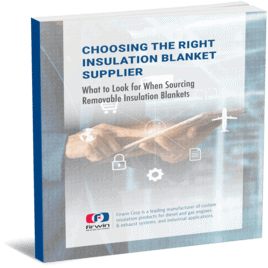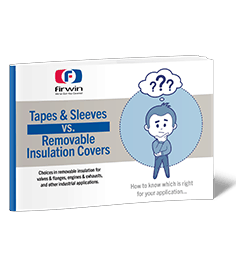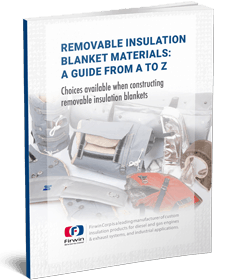Sound Attenuation: Diesel Powered Equipment
Diesel-powered equipment, with its many advantages, does have the drawback of being somewhat noisy. When placed in a room/enclosure with poor sound-absorption characteristics, this noise can be deafening and quite disturbing to those who find themselves in its vicinity.
As a manufacturer of removable insulation blankets, we are often called upon to provide sound attenuation as well. While standard removable insulation blankets do offer some sound attenuation properties, the correct solution is often a combination of removable blankets, composite foam barrier materials, insulation boards, and barrier curtains. The right choice depends on a number of factors particular to each situation.
Background: What is Sound?
Sound is a change in atmospheric pressure that is interpreted by the ear. The sound pressure level heard by a person in a room is determined both by the sound power radiated by the source of the sound and the acoustic characteristics of the room.
The most common way of measuring sound is in Decibels [dB], which measure both sound power and sound pressure levels and are expressed in logarithmic terms. Tolerable noise is accepted as 85dBs. (OSHA standard 29 CFR 1910.95).
To identify the root cause of a noise problem, sound has to be further analyzed into frequency levels [Hz Hertz], which for convenience are separated into 8 or 9 octaves on a frequency scale.
To engineer sound attenuation solutions, ideally, both the dB ratings and Octave band Frequency Analysis report are needed. This enables an Acoustics Engineer to address the complete situation within the practical limitations of the available materials and constraints of the individual case.
Sound Attenuation Solutions – Materials
Insulation solutions are based on using combinations of materials to absorb sound, offer barriers to sound, and close up places where there is sound leakage.
- Some materials, such as Fiberglass and Mineral wool, are particularly good in absorbing higher frequency sound in the 1000 to 4000 Hz ranges.
- Low-frequency sounds are difficult to absorb because of their long wavelengths. In general, the absorption of low-frequency sound increases with the thickness of the absorber or barrier.
- Sound will leak through openings where no sound insulation is in place.
To give some perspective to the effect of Sound barrier materials and their effectiveness over a full Octave band, here is the data for some typical materials used.
Comparative Charts of three typical absorber materials showing Sound Absorption and NRC [Noise Reduction Coefficients]
| Frequency [Hz] | 125 | 250 | 500 | 1000 | 2000 | 4000 | NRC |
| Material | |||||||
| Fibrous Glass 4lb/cu.ft | Sound Absorption Coefficients | ||||||
| 1” thick | .07 | .23 | .48 | .83 | .88 | .80 | .60 |
| 2” thick | .2 | .55 | .89 | .97 | .83 | .79 | .81 |
| Fibrous Glass 11lb/cu.ft | |||||||
| 1” thick | .29 | .86 | .95 | .92 | .95 | .75 | |
| Polyurethane Foam | |||||||
| [Open Cell] | |||||||
| 1” thick | .14 | .30 | .63 | .91 | .98 | .91 | .70 |
| 2” thick | .35 | .51 | .82 | .98 | .97 | .95 | .82 |
Chart showing Transmission Loss and STC [Standard Transmission Loss Coefficient] for a Composite Absorber/Barrier used for lining Engine Rooms and Containers
| Frequency [Hz] | 80 | 125 | 250 | 500 | 1000 | 2000 | 4000 | STC |
| Material | Transmission Loss [dB] | |||||||
| BTMM14C | 22 | 22 | 22 | 32 | 44 | 50 | 56 | 34 |
Typical Solutions – Panels, Absorbers, Blankets
Typical solutions for Engine Generator sets in engine rooms or containers are to insulate the walls with absorption materials made from fibrous glass/mineral wools or open cell foam panels butted tightly against each other. However this concentrates mainly on the upper Hz range and not the lower Hz range, so often composites such as Firwin BTMM14C are used, which offer better attenuation over the full octave spectrum. Composites include absorption materials and barrier materials together with a decoupler layer to separate the barrier from the room/container wall.
Where space considerations limit the use of wall/enclosure insulation, Removable Insulation Blankets can be used for the manifold, turbo, exhaust piping, silencers, etc. contained inside the room/enclosure. These blankets contain composites to bridge the full frequency band. In some situations, both wall insulated and engine and exhaust blanketed approaches together achieve the best solution. These blankets have both heat and sound insulation properties with a side benefit of energy conservation.
Factors to Consider for Proper Sound Attenuation
- The thickness of the materials used will affect the attenuation.
- All panels must be butted up to each other to assure that there is no sound leakage.
- Engines and other equipment must be mounted on vibration isolation mounts or pads to stop vibration and sound transmission.
- Baffle chambers and good Silencers are also important.
- Where space is at a premium and enclosures cannot be used, Removable Insulation blankets with built-in barriers are an answer. Because the Sound Insulation package is installed directly on the equipment, the attenuation is usually limited to no more than 8 to 10dB [provided the installation is done with care and diligence].
- Very often space and economic limitations will mean that the ultimate practical possible solution is not attainable.
Each project should be regarded as a separate case due to the multiplicity of variants from application to application.
Sound Attenuation Solutions – Materials Case Study – Combining Sound and Insulation into a Removable Cover
While the typical request for removable insulation blankets is to deal with heat-related issues, from time to time we also get requests for help on sound attenuation.
Sound attenuation solutions are based on using combinations of materials to absorb sound, offer barriers to sound, and close up places where there is sound leakage.
While we do offer a wide range of sound attenuation products (click here to view our sound attenuation product line), certain applications call for the combination of sound attenuation products within our removable insulation blankets. (For more information on sound attenuation, please see our Spring 2007 Insulation Insights newsletter).
Firwin Corp was recently commissioned to develop and install such a combination blanket for a large newsprint manufacturer. The company’s gas-fired power plant consisted of 10 CAT Natural Gas engines. Each engine had its own dedicated after‐treatment system, in this case, Miratech SCRs (Selective Catalytic Reduction).
Firwin was approached to design and install removable insulation blankets that would act as a combination of heat abatement and noise attenuation for these SCRs.
The company had an ambitious noise reduction requirement:
| Req’d Noise Control | Octave Band Center Frequency (Hz) | |||||||||
| 31.5 | 63 | 125 | 250 | 500 | 1000 | 2000 | 4000 | 8000 | ||
| Minimum Insertion Loss Req’d, | 2 | 6 | 15 | 23 | 23 | 25 | 25 | 25 | 16 | |
| SCR Lagging (dB) | ||||||||||
“For that level of noise reduction, we needed to go with 4” thick blankets,” said Jon Miles, Firwin’s Design Manager. “We also decided to incorporate a Noise Block sound barrier into the blanket design, to arrive at the noise control goals over the frequency range that the client specified,” added Jon.
Because of the large size of these SCRs and the thickness of the insulation blankets, the blankets needed to be designed in a ‘multipart / multilayer’ format, to facilitate handling and weight restrictions per piece. Other factors complicating the design were ensuring that access ports to the SCRs were left open, and staggering the blanket ‘joins / seams’ to ensure a snug fit and optimal noise reduction.
What follows is an illustrated timeline of how the blankets were assembled:
Miratech SCR ‐ PreInsulation
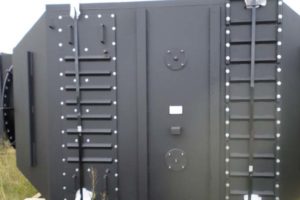
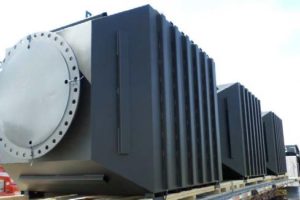
Installation – Inner Layer
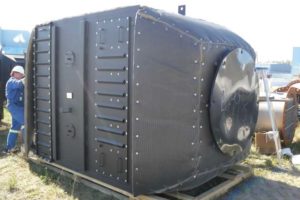
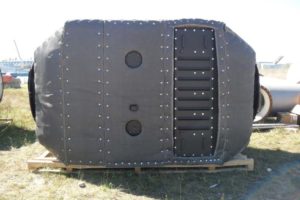
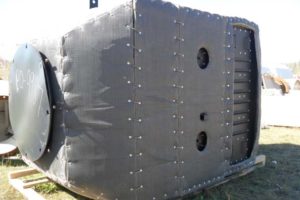
Installation – Outer Layer
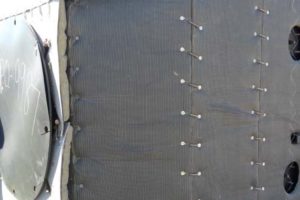
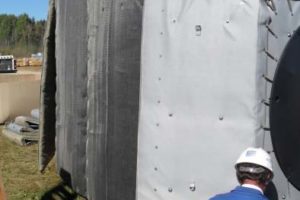
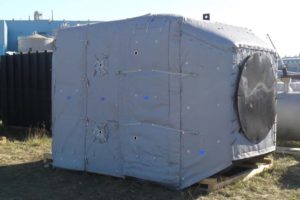
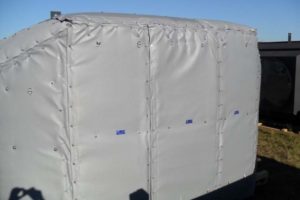
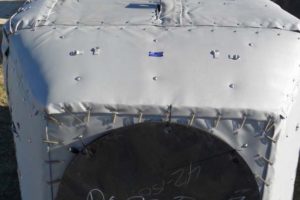
Complete Insulation and Installed
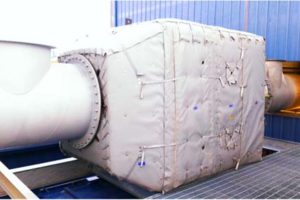
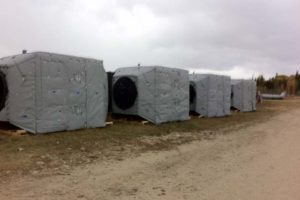
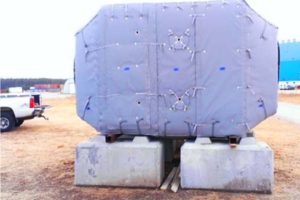
“This was quite the challenging project”, notes Jon. “But it really showcases Firwin’s strengths as a complete insulation solutions provider – from our ability to work with our clients to understand their needs, select the right materials and design, all the way to ensuring proper installation.”
Sound Attenuation Products
At Firwin Corporation, we are a premier manufacturer of custom insulation products. In addition to offering a comprehensive selection of thermal insulation solutions, we maintain a range of stock sound attenuation products. From barriers and curtains to panels and lagging, we can provide noise absorption and dampening solutions suitable for various industries and applications. Our materials help companies establish better and safer work environments by decreasing noise levels.
AcoustiGuard™ Acoustic Curtain Systems
AcoustiGuard acoustic curtain systems are suitable noise control solutions for locations where hard panel enclosures or solid walls are not appropriate due to access or production requirements and restrictions. They are used for a variety of purposes, including noisy equipment enclosures, plant dividers, moveable screens, office crosstalk barriers, and operator noise shields.
AcoustiGuard Quilted Barrier / Absorber Curtain Panels
AcoustiGuard quilted barrier and absorber curtains combine the characteristics of high-mass acoustic barriers and durable quilted sound-absorbing facings. These noise control products deliver superior transmission loss and noise level reduction even on the “noise” side of the curtain. They are used to enclose noise sources and isolate areas from noisy production machinery.
High-Efficiency — Economical Noise Enclosures
Our high-efficiency, economical noise enclosures are made from sheet metal or plywood lined with an acoustic composite. They can be used to solve a variety of noise problems encountered in industrial and OEM applications and integrated into various enclosure applications.
High-Efficiency — Economical Noise Control Barriers
Our high-efficiency, economical noise control barriers are wraps designed to control noise leakage or penetration. They are suitable for indoor and outdoor use. Typical applications include ducting, fans, panels, piping, pumps, and stacks.
AcoustiGuard LAG ‘FR’ and LAG ‘FRC’ Acoustical Pipe and Duct Lagging
AcoustiGuard LAG ‘FR’ and LAG ‘FRC’ acoustical pipe and duct lagging consist of loaded vinyl reinforced with aluminum foil facing on one side. The vinyl material offers flexibility and thickness, while the aluminum foil enhances mechanical strength, weatherability, fire retardance, and appearance. Typical applications include ductwork, heat exchangers, mixing boxes, process piping, and valves.
AcoustiGuard Quilted Absorption Panels
AcoustiGuard quilted absorption panels consist of vinyl-coated fiberglass cloth quilted to fiberglass absorption material. They are designed for easy installation on factory walls. Typical applications include absorptive lining for reflective surfaces, attractive suspending baffles, decorative cloth facing for architectural structures, and noise absorption liners for engines compartments and equipment housings.
Conasorb UF
Combining urethane film and polyester polyurethane acoustic foam, Conasorb UF is highly durable and elastic. It is suitable for use in environments where exposure to dirt, water, and/or industrial fluids is likely. Typical applications include enclosure and silencer liners, engine compartments, machine guarding liners.
Conasorb V
Conasorb V consists of perforated vinyl film bonded to polyester polyurethane foam. It has a scuff- and wear-resistant surface, which makes it ideal for dusty and moderately dirty environments where exposure to direct oil, water spray, and other similar contaminants is not likely. It is suitable for use as enclosures or room surface absorbers that require functionally attractive or cleanable surfaces.
Conasorb FTMM
Conasorb FTMM is formulated to absorb airborne, random incidence noise. It consists of a flexible polyester polyurethane acoustic foam with a silver, metalized polyester film surface. It is highly resistant to contamination, making it suitable for use in environments where exposure to direct oil, water spray, and other similar contaminants is likely.
Barymat 5
Barymat 5 is a thin, dense, plain noise barrier material. It can be applied by itself or in combination with other acoustic products if high transmission loss is needed. It is used for acoustic wraps, ceilings, floors, and walls.
Barymat BM-1C
Barymat BM-1C is highly versatile and durable. It is excellent at reducing breakout noise in ducts and piping and increasing transmission loss in ceilings and walls.
Barymat BV-14C
Barymat BV-14C is a composite noise barrier/absorption material. It is best suited for moderately dirty environments where exposure to direct oil, water spray, and other similar contaminants is not likely.
Barymat BTMM-14C
Barymat BTMM-14C is a durable and versatile noise barrier/absorption material. It consists of metalized mylar facing, acoustic urethane foam, flexible barrier material, and a urethane foam decoupler. It is ideal for extremely dirty, oily, or wet environments.
Barymat M-100D
Barymat M-100D is designed for use in applications where high sound transmission loss, good heat insulation, and abrasion resistance are critical. It is suitable for permanent or semi-permanent installations.
Barymat M-600 D
Barymat M-600 D offers excellent vibration isolation and scuff resistance. Typical applications include control room floors, firewall barriers, and vehicle floors.
Barymat BGM 7-4B
Barymat BGM 7-4B is typically used as engine compartment liners or thermal acoustic decouplers. It is made from limp, dense, mineral-filler plastic barrier designed for maximum transmission loss for its weight.
Wildamp
Wildamp sheet form sound deadeners are used to control resonant vibrations in sheet metal structures. They also reduce the duration and loudness of random impact noises. Typical applications include appliance cabinets, ductwork, machine housings, metal office furniture, and vehicle body panels.
1099 Plastic Adhesive
1099 plastic adhesive is suitable for use with any AcoustiGuard roll or sheet goods. Additionally, it will not damage or react with Conasorb acoustic foam or Barymat barrier products. It adheres well to many substrates, including metal, wood, glass, plastic, rubber, and vinyl.
Super 74 Fastfoam Adhesive
Super 74 Fastfoam adhesive is a spray adhesive suitable for covering small areas. It is used for installing in tight spaces and performing quick repairs. It adheres well to various substrates, including foam, metal, wood, hardboard, glass, fabric, and fiberglass.
Sound Attenuation Solutions from Firwin
Firwin is an industry-leading manufacturer and provider of custom insulation products for exhaust systems, diesel and gas engines, and various industrial applications. Our sound attenuation solutions effectively absorb or dampen noise in a range of environments. For more information about how Firwin can help you with your insulation and sound attenuation needs, contact us or request a quote today.

